Integrated Assessment Modeling of China’s Shale Gas Resource: Energy System Optimization, Environmental Cobenefits, and Methane Risk
Abstract
1. Introduction
2. Methodology
2.1. Model Description
2.2. Supply Curve
2.3. Scenario Design of Shale Gas Development
3. Results on Energy System Optimization
3.1. Final Energy Demands
3.2. Primary Energy Demand
3.3. Power Generation Structure
3.4. Carbon Emissions
4. Key Local Pollutant Emissions and Environmental Health Impacts
4.1. Emissions of SO2 and NOX
4.2. Environmental Health Impacts of SO2 and NOX
4.3. Methane Leakage
4.4. Environmental Health Impact of Methane
4.5. Economic Loss Avoided
5. Conclusions and Discussion
Author Contributions
Funding
Acknowledgments
Conflicts of Interest
Abbreviations
| bcm | billion cubic meters |
| China-MAPLE | China-Multi-pollutant Abatement Planning and Long-term benefit Evaluation |
| CN | Changing Exploration and Development Zone |
| CO2 | Carbon dioxide |
| CQ | Chongqing |
| EIA | U.S. Energy Information Administration |
| FL | Fuling Exploration and Development Zone |
| GZ | Guizhou Province |
| HB | Hubei Province |
| HN | Hunan Province |
| kt | Kiloton |
| Mtce | Millon tons of coal equivalents |
| NDRC | National Development and Reform Commission |
| NOx | Nitrogen oxide |
| REF | Reference |
| RMB | Renminbi |
| SC | Sichuan Province |
| ST | Shaotong Exploration and Development Zone |
| SGMD | Shale gas moderate development |
| SGAD | Shale gas ambitious development |
| SO2 | Sulfur dioxide |
| SX | Shanxi Province |
| tce | ton of standard coal equivalent |
| Twh | Tera Watt Hour(s) |
| UNDP | United Nations Development Programme |
| WY | Weiyuan Exploration and Development Zone |
| XJ | Xinjiang Uygur Autonomous Region |
| YA | Yan’an Exploration and Development Zone |
| YN | Yunnan Province |
References
- EIA Official Website. Available online: https://www.eia.gov/outlooks/aeo/nems/documentation/ogsm/pdf/m063(2018).pdf (accessed on 18 August 2020).
- Chen, S.; Zhu, Y.; Wang, H.; Liu, H.; Wei, W.; Luo, Y.; Li, W.; Fang, J. Research status and trends of shale gas in China. Acta Pet. Sin. 2010, 31, 689–694. (In Chinese) [Google Scholar]
- Westaway, R.; Younger, P.L.; Cornelius, C. Comment on ‘Life cycle environmental impacts of UK shale gas’ by L. Stamford and A. Azapagic. Applied Energy, 134, 506–518, 2014. Appl. Energy 2015, 148, 489–495. [Google Scholar] [CrossRef]
- Stamford, L.; Azapagic, A. Response to the Comment by Westaway et al. (Applied Energy 148 (2015) 489–495) on the paper “Life cycle environmental impacts of UK shale gas” by Stamford and Azapagic (Applied Energy 134 (2014) 506–518). Appl. Energy 2015, 155, 947–948. [Google Scholar] [CrossRef]
- Westaway, R.; Younger, P.L.; Cornelius, C. Corrigendum to “Comment on ‘Life cycle environmental impacts of UK shale gas’ by L. Stamford and A. Azapagic. Applied Energy 134, 506–518, 2014” [Appl. Energy 148 (2015) 489–495]. Appl. Energy 2015, 155, 949. [Google Scholar] [CrossRef]
- Absar, S.M.; Boulay, A.; Campa, M.F.; Preston, B.L.; Taylor, A. The tradeoff between water and carbon footprints of Barnett Shale gas. J. Clean. Prod. 2018, 197, 47–56. [Google Scholar] [CrossRef]
- Turk, J.K.; Reay, D.S.; Haszeldine, R.S. Gas-fired power in the UK: Bridging supply gaps and implications of domestic shale gas exploitation for UK climate change targets. Sci. Total Environ. 2018, 616–617, 318–325. [Google Scholar] [CrossRef]
- BP Official Website. Available online: https://www.bp.com/en/global/corporate/news-and-insights/press-releases/bp-statistical-review-of-world-energy-2020-published.html (accessed on 18 August 2020).
- EIA Official Website. Available online: https://www.eia.gov/naturalgas/crudeoilreserves/pdf/usreserves.pdf (accessed on 18 August 2020).
- NBSPRC (National Bureau of Statistics of the People’s Republic of China) Official Website. Available online: http://data.stats.gov.cn/easyquery.htm?cn=C01&zb=A070B&sj=2019 (accessed on 18 August 2020).
- Cooper, J.; Stamford, L.; Azapagic, A. Social sustainability assessment of shale gas in the UK. Sustain. Prod. Consum. 2018, 14, 1–20. [Google Scholar] [CrossRef]
- Cooper, J.; Stamford, L.; Azapagic, A. Sustainability of UK shale gas in comparison with other electricity options: Current situation and future scenarios. Sci. Total Environ. 2018, 619–620, 804–814. [Google Scholar] [CrossRef]
- Jenner, S.; Lamadrid, A.J. Shale gas vs. coal: Policy implications from environmental impact comparisons of shale gas, conventional gas, and coal on air, water, and land in the United States. Energy Policy 2013, 53, 442–453. [Google Scholar] [CrossRef]
- Bunch, A.G.; Perry, C.S.; Abraham, L.; Wikoff, D.S.; Tachovsky, J.A.; Hixon, J.G.; Urban, J.D.; Harris, M.A.; Haws, L.C. Evaluation of impact of shale gas operations in the Barnett Shale region on volatile organic compounds in air and potential human health risks. Sci. Total Environ. 2014, 468–469, 832–842. [Google Scholar] [CrossRef]
- Bilgilih, F.; Koçak, E.; Bulut, U.; Sualp, M.N. How did the US economy react to shale gas production revolution? An advanced time series approach. Energy 2016, 116, 963–977. [Google Scholar] [CrossRef]
- Solarin, S.A.; Bello, M.O. The impact of shale gas development on the U.S economy: Evidence from a quantile autoregressive distributed lag model. Energy 2020, 205, 118004. [Google Scholar] [CrossRef]
- Grecu, E.; Aceleanu, M.I.; Albulescu, C.T. The economic, social and environmental impact of shale gas exploitation in Romania: A cost-benefit analysis. Renew. Sustain. Energy Rev. 2018, 93, 691–700. [Google Scholar] [CrossRef]
- Saussay, A. Can the US shale revolution be duplicated in continental Europe? An economic analysis of European shale gas resources. Energy Econ. 2018, 69, 295–306. [Google Scholar] [CrossRef]
- Cooper, J.; Stamford, L.; Azapagic, A. Economic viability of UK shale gas and potential impacts on the energy market up to 2030. Appl. Energy 2018, 215, 577–590. [Google Scholar] [CrossRef]
- Chen, Y.; Li, J.; Lu, H.; Xia, J. Tradeoffs in water and carbon footprints of shale gas, natural gas, and coal in China. Fuel 2020, 263, 16778. [Google Scholar] [CrossRef]
- Zeng, S.; Gu, J.; Yang, S.; Zhou, H.; Qian, Y. Comparison of techno-economic performance and environmental impacts between shale gas and coal-based synthetic natural gas (SNG) in China. J. Clean. Prod. 2019, 215, 544–556. [Google Scholar] [CrossRef]
- Chang, Y.; Huang, R.; Ries, R.J.; Masanet, E. Life-cycle comparison of greenhouse gas emissions and water consumption for coal and shale gas fired power generation in China. Energy 2015, 86, 335–343. [Google Scholar] [CrossRef]
- Shen, S. Scenario Simulation and Uncertainty Analysis of Shale Gas Emission Reduction Potential in Power Industry. Master’s Thesis, Tsinghua University, Beijing, China, 2017. (In Chinese). [Google Scholar]
- Zhang, Y.; Wang, H.; Han, Y.; Wang, D.; Zhu, G.; Lu, X. Shale gas development in China: Implications for indoor and outdoor air quality and greenhouse gas emissions. Environ. Int. 2020, 141, 105727. [Google Scholar] [CrossRef]
- Li, X.; Mao, H.; Ma, Y.; Wang, B.; Liu, W.; Xu, W. Life cycle greenhouse gas emissions of China shale gas. Resour. Conserv. Recycl. 2020, 152, 104518. [Google Scholar] [CrossRef]
- Bo, S. Analysis and research on economic benefits of shale gas development. Huabei Nat. Resour. 2014, 4, 123–124. [Google Scholar]
- Rivard, C.; Lavoie, D.; Lefebvre, R.; Séjourné, S.; Lamontagne, C.; Duchesne, M. An overview of Canadian shale gas production and environmental concerns. Int. J. Coal Geol. 2014, 126, 64–76. [Google Scholar] [CrossRef]
- Sangaramoorthy, T. Maryland is not for Shale: Scientific and public anxieties of predicting health impacts of fracking. Extr. Ind. Soc. 2019, 6, 463–470. [Google Scholar] [CrossRef]
- Hill, E.L. Shale gas development and infant health: Evidence from Pennsylvania. J. Health Econ. 2018, 61, 134–150. [Google Scholar] [CrossRef]
- Zhang, W.; Yang, J.; Zhang, Z.; Shackman, J.D. Natural gas price effects in China based on the CGE model. J. Clean. Prod. 2017, 147, 497–505. [Google Scholar] [CrossRef]
- Zhang, S.; Wang, C.; Cai, W. How Shale Gas will Shape China’s Future? An Evaluation Based on Dynamic Energy-CGE Model. Energy Procedia 2017, 105, 3349–3354. [Google Scholar] [CrossRef]
- Shaw, J.T.; Allen, G.; Pitt, J.; Mead, M.I.; Purvis, R.M.; Dunmore, R.; Wilde, S.; Shah, A.; Barker, P.; Bateson, P.; et al. A baseline of atmospheric greenhouse gases for prospective UK shale gas sites. Sci. Total Environ. 2019, 684, 1–13. [Google Scholar] [CrossRef]
- Purvis, R.M.; Lewis, A.C.; Hopkins, J.R.; Wilde, S.E.; Dunmore, R.E.; Allen, G.; Pitt, J.; Ward, R.S. Effects of ‘pre-fracking’ operations on ambient air quality at a shale gas exploration site in rural North Yorkshire, England. Sci. Total Environ. 2019, 673, 445–454. [Google Scholar] [CrossRef]
- Umeozor, E.C.; Jordaan, S.M.; Gates, I.D. On methane emissions from shale gas development. Energy 2018, 152, 594–600. [Google Scholar] [CrossRef]
- Ahmadi, M.; John, K. Statistical evaluation of the impact of shale gas activities on ozone pollution in North Texas. Sci. Total Environ. 2015, 536, 457–467. [Google Scholar] [CrossRef]
- Lim, G.Q.; John, K. Impact of energy production in the Barnett Shale gas region on the measured ambient hydrocarbon concentrations in Denton, Texas. Atmos. Pollut. Res. 2020, 11, 409–418. [Google Scholar] [CrossRef]
- Xu, B.; Feng, L.; Wang, J.; Wei, W. The Enlightenment from Methane Control Measures in the U.S. Shale Gas Development. Ecol. Econ. 2016, 32, 106–110. [Google Scholar]
- Yu, G.; Wu, Q. Assessment on the environmental benefits of shale gas development and utilization in China. China Min. Mag. 2015, 24, 24–28. (In Chinese) [Google Scholar]
- Castellani, B.; Rinaldi, S.; Morini, E.; Nastasi, B.; Rossi, F. Flue gas treatment by power-to-gas integration for methane and ammonia synthesis – Energy and environmental analysis. Energy Convers. Manag. 2018, 171, 626–634. [Google Scholar] [CrossRef]
- Guilera, J.; Andreu, T.; Basset, N.; Boeltken, T.; Timm, F.; Mallol, I.; Morante, J.R. Synthetic natural gas production from biogas in a waste water treatment plant. Renew. Energy 2020, 146, 1301–1308. [Google Scholar] [CrossRef]
- Castellani, B.; Gambelli, A.M.; Morini, E.; Nastasi, B.; Presciutti, A.; Filipponi, M.; Nicolini, A.; Rossi, F. Experimental Investigation on CO2 Methanation Process for Solar Energy Storage Compared to CO2-Based Methanol Synthesis. Energies 2017, 10, 855. [Google Scholar] [CrossRef]
- Blythe, K.; Jeffries, R.; Travers, M. Chapter 13—An International Perspective of Challenges and Constraints in Shale Gas Extraction. In Environmental and Health Issues in Unconventional Oil and Gas Development; Elsevier: Amsterdam, The Netherlands, 2016; pp. 225–248. [Google Scholar]
- Theodori, G.L. Shale energy development in the Southern United States: A review of perceived and objective social impacts. Extr. Ind. Soc. 2018, 5, 610–618. [Google Scholar] [CrossRef]
- Tan, H.; Wong-Parodi, G.; Xu, J. Not under my backyard? Psychological distance, local acceptance, and shale gas development in China. Energy Res. Soc. Sci. 2020, 61, 101336. [Google Scholar] [CrossRef]
- Shang, W.; Tiraferri, A.; He, Q.; Li, N.; Chang, H.; Liu, C.; Liu, B. Reuse of shale gas flowback and produced water: Effects of coagulation and adsorption on ultrafiltration, reverse osmosis combined process. Sci. Total Environ. 2019, 689, 47–56. [Google Scholar] [CrossRef]
- Liang, X.; Xu, Z.; Zhang, Z.; Wang, W.; Zhang, J.; Lu, H.; Zhang, L.; Zou, C.; Wang, G.; Mei, J.; et al. Breakthrough of shallow shale gas exploration in Taiyang anticline area and its significance for resource development in Zhaotong, Yunnan Province, China. Pet. Explor. Dev. 2020, 47, 12–29. [Google Scholar] [CrossRef]
- Han, S.; Bai, S.; Tang, Z.; Rui, Y.; Gong, D.; Zhang, J. Nitrogen-rich gas shale logging evaluation and differential gas-bearing characterization of lower Cambrian formation in northern Guizhou, south China. Mar. Pet. Geol. 2020, 115, 104270. [Google Scholar] [CrossRef]
- Zou, C.; Dong, D.; Wang, Y.; Li, X.; Huang, J.; Wang, S.; Guan, Q.; Zhang, C.; Wang, H.; Liu, H.; et al. Shale gas in China: Characteristics, challenges and prospects (II). Pet. Explor. Dev. 2016, 43, 182–196. [Google Scholar] [CrossRef]
- Iddphonce, R.; Wang, J.; Zhao, L. Review of CO2 injection techniques for enhanced shale gas recovery: Prospect and challenges. J. Nat. Gas Sci. Eng. 2020, 77, 103240. [Google Scholar] [CrossRef]
- Liu, J.; Liang, X.; Xue, Y.; Yao, K.; Fu, Y. Numerical evaluation on multiphase flow and heat transfer during thermal stimulation enhanced shale gas recovery. Appl. Therm. Eng. 2020, 178, 115554. [Google Scholar] [CrossRef]
- Liu, J.; Li, Z.; Luo, D.; Duan, X.; Liu, R. Shale gas production in China: A regional analysis of subsidies and suggestions for policy. Util. Policy 2020, 67, 101135. [Google Scholar] [CrossRef]
- Bai, Y.; Meng, J.; Meng, F.; Fang, G. Stochastic analysis of a shale gas investment strategy for coping with production uncertainties. Energy Policy 2020, 144, 111639. [Google Scholar] [CrossRef]
- Chen, Y.; Xu, J.; Wang, P. Shale gas potential in China: A production forecast of the Wufeng-Longmaxi Formation and implications for future development. Energy Policy 2020, 147, 111868. [Google Scholar] [CrossRef]
- Zhang, Q.; Grohmann, S.; Xu, X.; Littke, R. Depositional environment and thermal maturity of the coal-bearing Longtan Shale in southwest Guizhou, China: Implications for shale gas resource potential. Int. J. Coal Geol. 2020, 231, 103607. [Google Scholar] [CrossRef]
- Han, H.; Pang, P.; Zhong, N.; Luo, Q.; Ma, Y.; Gao, Y. The pore characteristics and gas potential of the Jurassic continental shales in the middle-small basins, northwest China. J. Pet. Sci. Eng. 2020, 188, 106873. [Google Scholar] [CrossRef]
- Fan, C.; Li, H.; Qin, Q.; He, S.; Zhong, C. Geological conditions and exploration potential of shale gas reservoir in Wufeng and Longmaxi Formation of southeastern Sichuan Basin. China. J. Pet. Sci. Eng. 2020, 191, 107138. [Google Scholar] [CrossRef]
- Wan, Y.; Tang, S.; Pan, Z. Evaluation of the shale gas potential of the lower Silurian Longmaxi Formation in northwest Hunan Province, China. Mar. Pet. Geol. 2017, 79, 159–175. [Google Scholar] [CrossRef]
- Zeng, S. Technology-Economic Analysis and Environmental Impacts Assessment of Shale Oil and Shale Gas Development in China. Master’s Thesis, South China University of Technology, Guangzhou, China, 2019. [Google Scholar]
- Wang, Q.; Zhan, L. Assessing the sustainability of the shale gas industry by combining DPSIRM model and RAGA-PP techniques: An empirical analysis of Sichuan and Chongqing, China. Energy 2019, 176, 353–364. [Google Scholar] [CrossRef]
- The Center on Global Energy Policy of Columbia Univerisity. Available online: https://energypolicy.columbia.edu/sites/default/files/China%20Shale%20Gas_WORKING%20DRAFT_Sept%2011_Chinese%20langugage%20version.pdf (accessed on 18 December 2020).
- The People’s Government of Sichuan Province. Available online: http://www.sc.gov.cn/10462/c103044/2017/3/2/ad8905f6fc674a209bf084e26b82f79f.shtml (accessed on 14 December 2020).
- Chongqing Municipal People’s Government. Available online: http://www.cq.gov.cn/zwgk/fdzdgknr/lzyj/qtgw/202001/t20200114_4617664.html (accessed on 14 December 2020).
- China Geological Survey. Available online: https://www.cgs.gov.cn/xwl/ddyw/201603/t20160309_303928.html (accessed on 14 December 2020).
- Strategic Research Center of Oil and Gas Resources. National Shale Gas. Resource Potential Investigation Evaluation and Advantageous Area Selection; Science Press: Beijing, China, 2016. [Google Scholar]
- China Official Website. Available online: http://www.mnr.gov.cn/sj/sjfw/kc_19263/zgkczybg/201910/t20191022_2473040.html (accessed on 18 August 2020).
- National Energy Administration Official Website. Available online: http://www.gov.cn/xinwen/2016-09/30/content_5114313.htm (accessed on 18 August 2020).
- The 10th China Gas Summit (CSGS). Available online: http://shalegas.zhenweievents.com/cn/news/list_104_1.html (accessed on 14 December 2020).
- PetroChina Southwest Oil & GasField Company. Available online: http://xnyqt.cnpc.com.cn/xnyqt/sylmtydt/202004/cf26657ac7f34b6783e10eb41372153f.shtml (accessed on 14 December 2020).
- BP Official Website. Available online: https://www.bp.com/content/dam/bp/business-sites/en/global/corporate/pdfs/energy-economics/energy-outlook/bp-energy-outlook-2014.pdf (accessed on 18 August 2020).
- Zhu, S. Fugitive Emission of Greenhouse Gas from Oil and Gas System in Canada. Environ. Prot. Oil Gas Fields 2005, 15, 4–6. (In Chinese) [Google Scholar]
- NDRC/UNDP. China Prepares for the Third National Communication Capacity Building Project: China’s 2012 National Gree Gas Inventory-Energy Activity List. National Center for Climate Change Strategy and International Cooperation; Energy Research Institute National Development and Reform Commission: Beijing, China, 2017.
- IPCC Official Website. Available online: https://www.ipcc.ch/report/2019-refinement-to-the-2006-ipcc-guidelines-for-national-greenhouse-gas-inventories/ (accessed on 18 August 2020).
- IPCC Official Website. Available online: https://www.ipcc.ch/report/ar5/wg1/ (accessed on 7 December 2020).
- Lü, L.; Zhang, X.; Pang, W.; Wang, J.; Luo, H. Study on the environmental impact of implementing “Shale Gas Development Plan (2016–2020)”. Nat. Gas Ind. 2017, 37, 132–138. (In Chinese) [Google Scholar]
- BP Official Website. Available online: https://www.bp.com/en/global/corporate/news-and-insights/press-releases/bp-statistical-review-of-world-energy-2019.html (accessed on 18 August 2020).
- Negi, B.S.; Pandey, K.K.; Sehgal, N. Renewables, Shale Gas and Gas Import- Striking a Balance for India. Energy Procedia 2017, 105, 3720–3726. [Google Scholar] [CrossRef]
- Andreasson, S. The bubble that got away? Prospects for shale gas development in South Africa. Extr. Ind. Soc. 2018, 5, 453–460. [Google Scholar] [CrossRef]
- Lis, A. Co-production of the shale gas publics in Poland and the negotiation of the state citizens relations. Extr. Ind. Soc. 2018, 5, 673–681. [Google Scholar] [CrossRef]
- Dong, K.; Sun, R.; Hochman, G. Do natural gas and renewable energy consumption lead to less CO2 emission? Empirical evidence from a panel of BRICS countries. Energy 2017, 141, 1466–1478. [Google Scholar] [CrossRef]
- Altieri, K.E.; Stone, A. Prospective air pollutant emissions inventory for the development and production of unconventional natural gas in the Karoo basin, South Africa. Atmos. Environ. 2016, 129, 34–42. [Google Scholar] [CrossRef]
- Kumar, V.V.; Shastri, Y.; Hoadley, A. A consequence analysis study of natural gas consumption in a developing country: Case of India. Energy Policy 2020, 145, 111675. [Google Scholar] [CrossRef]
- Lin, B.; Agyeman, S. Impact of natural gas consumption on sub-Saharan Africa’s CO2 emissions: Evidence and policy perspective. Sci. Total Environ. 2020, 2, 143321. [Google Scholar] [CrossRef] [PubMed]
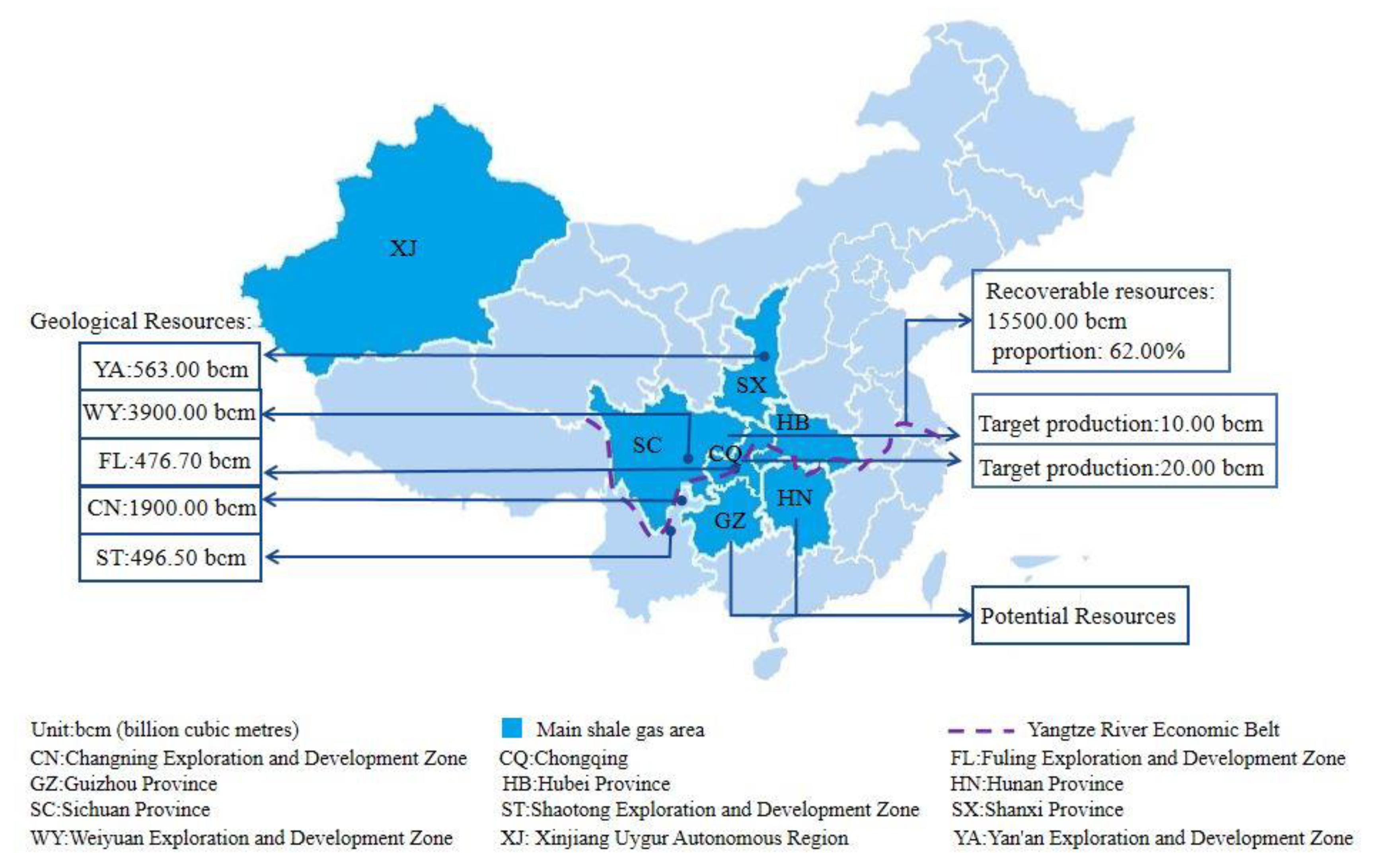


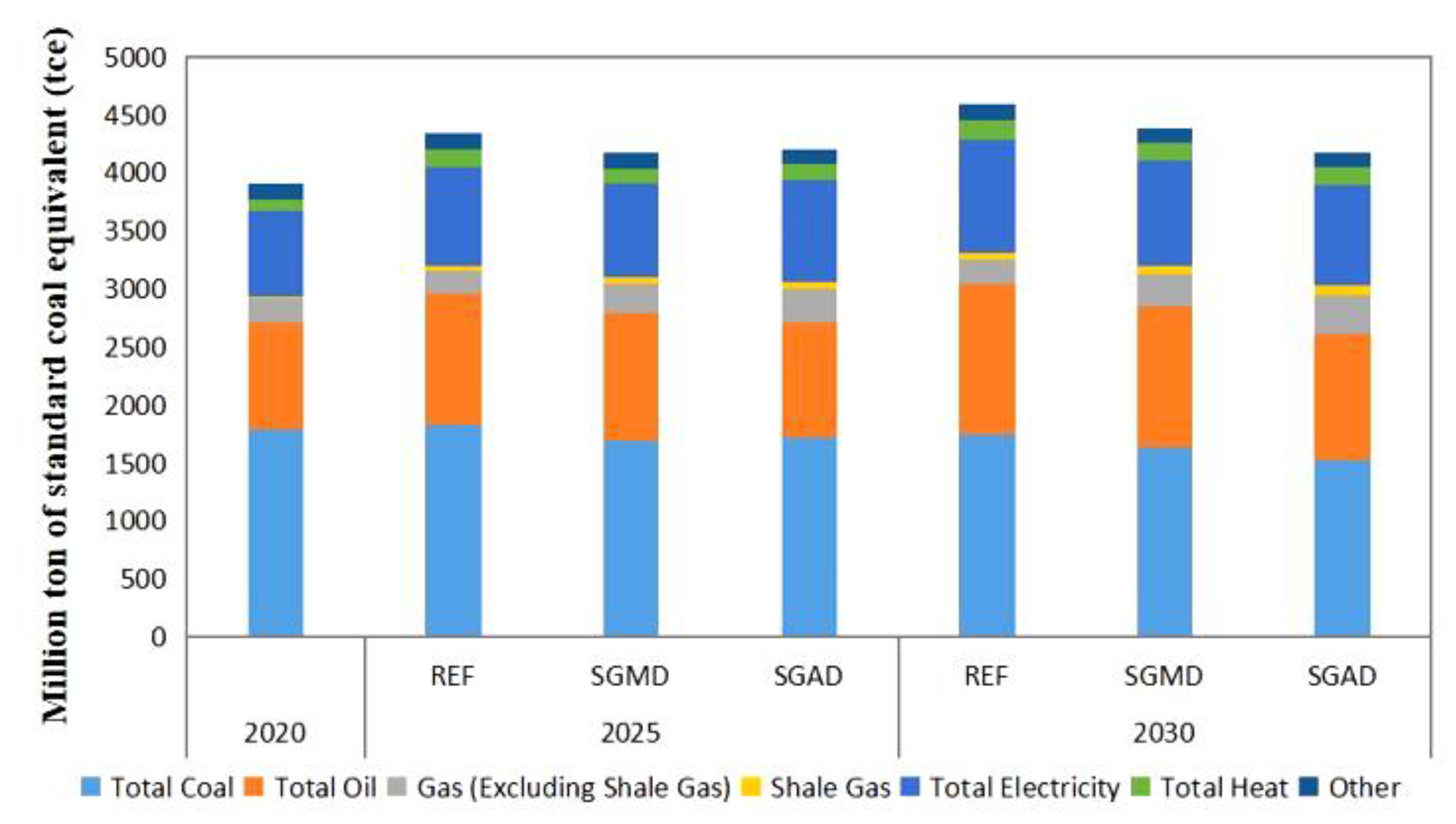
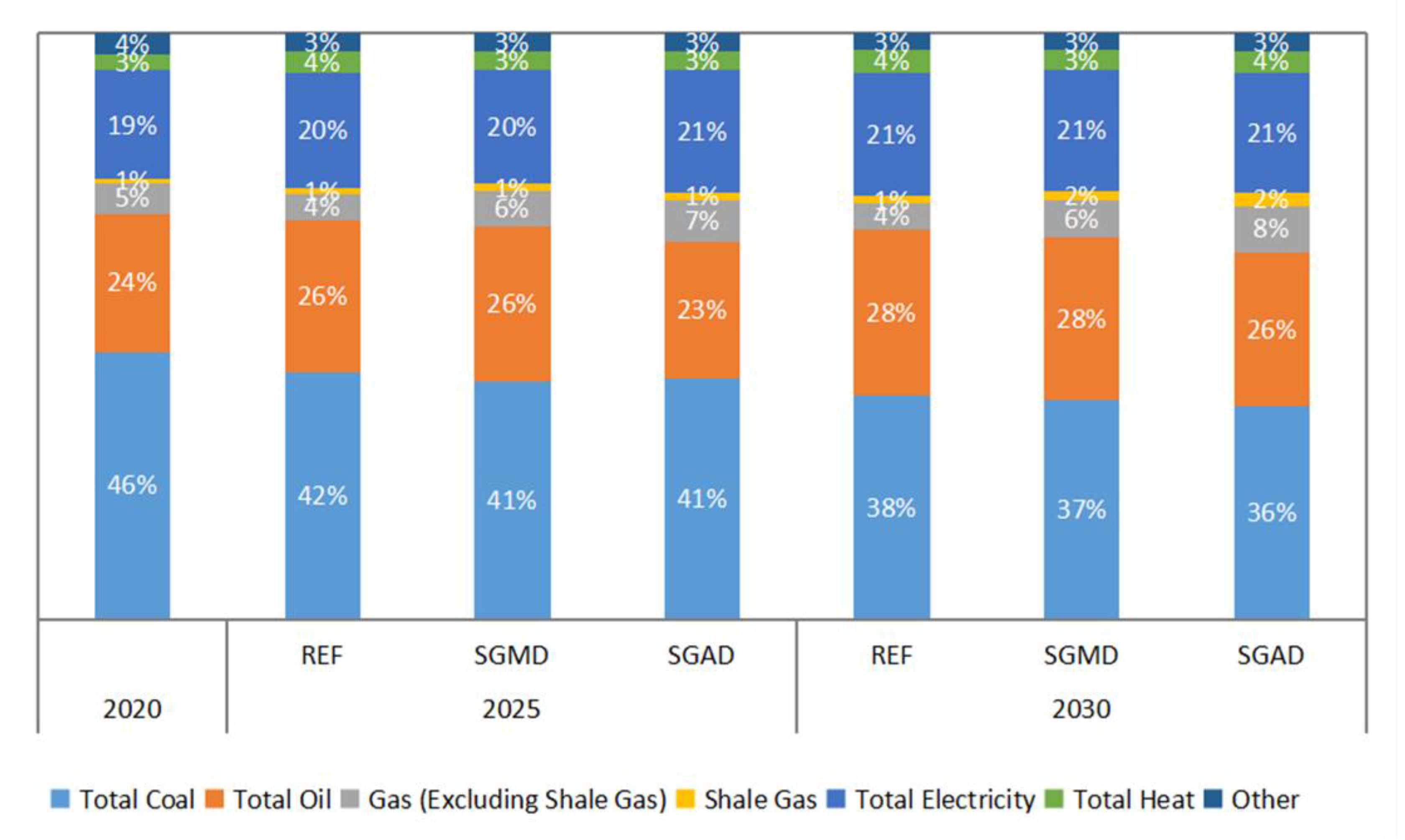

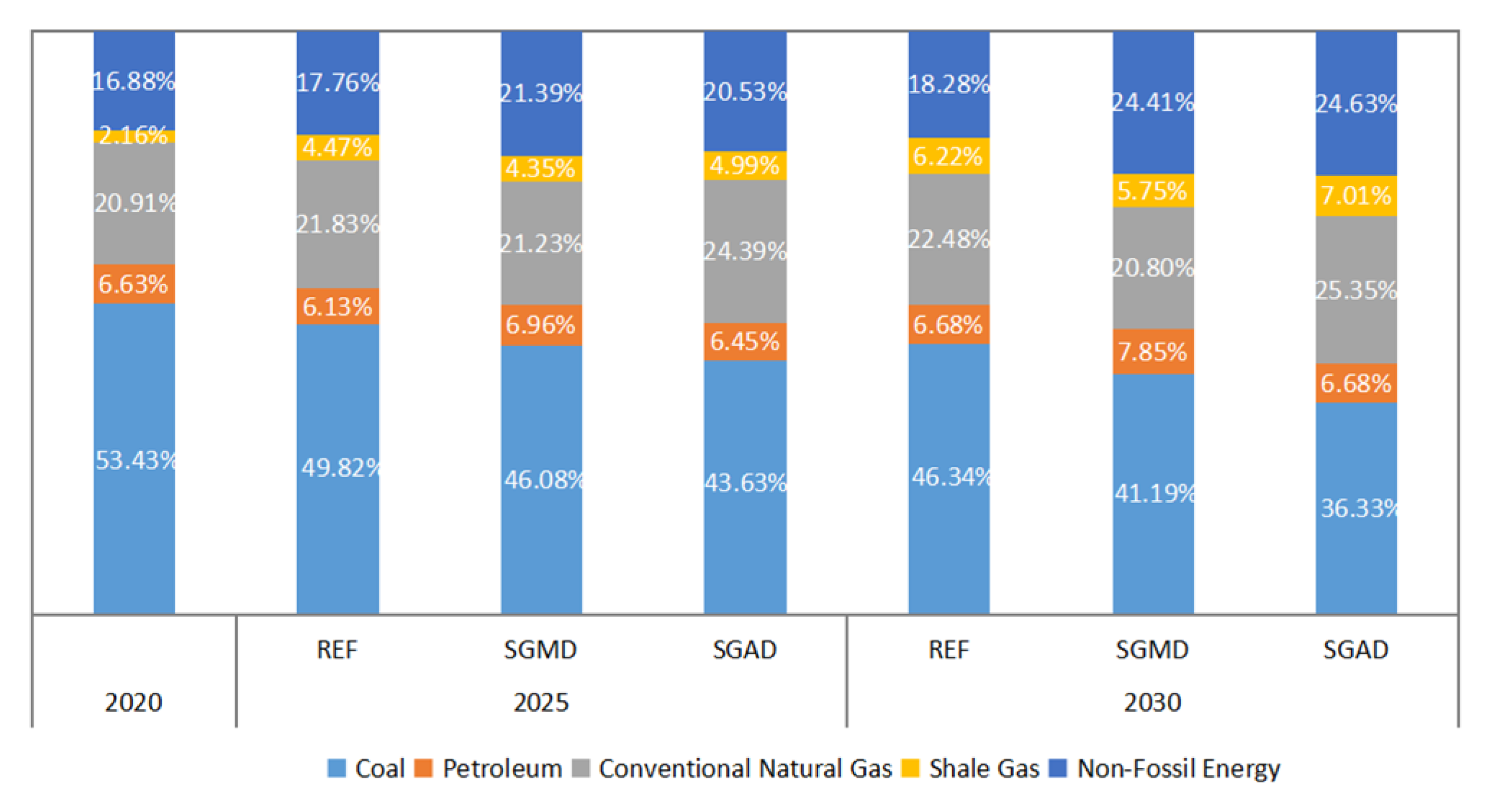

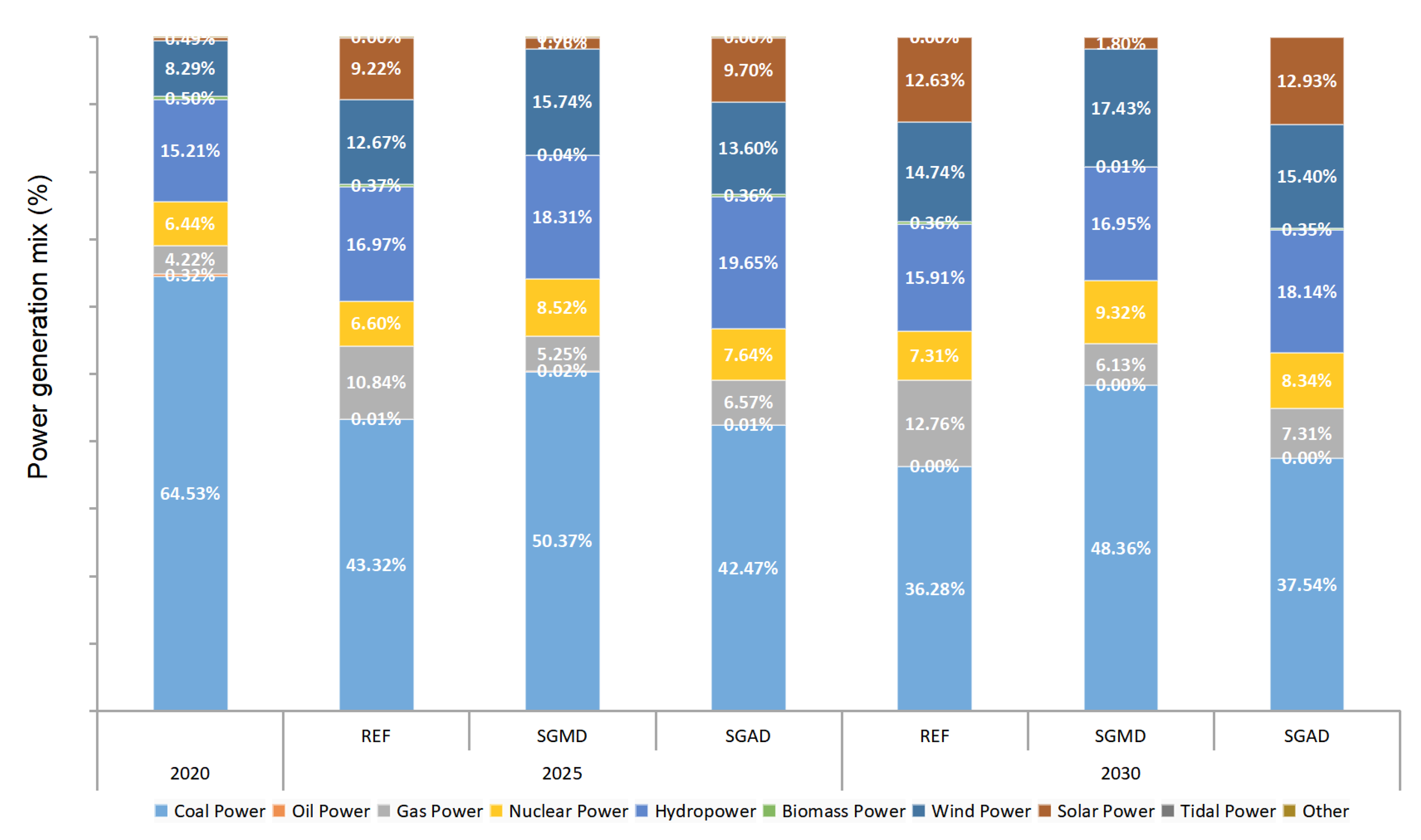
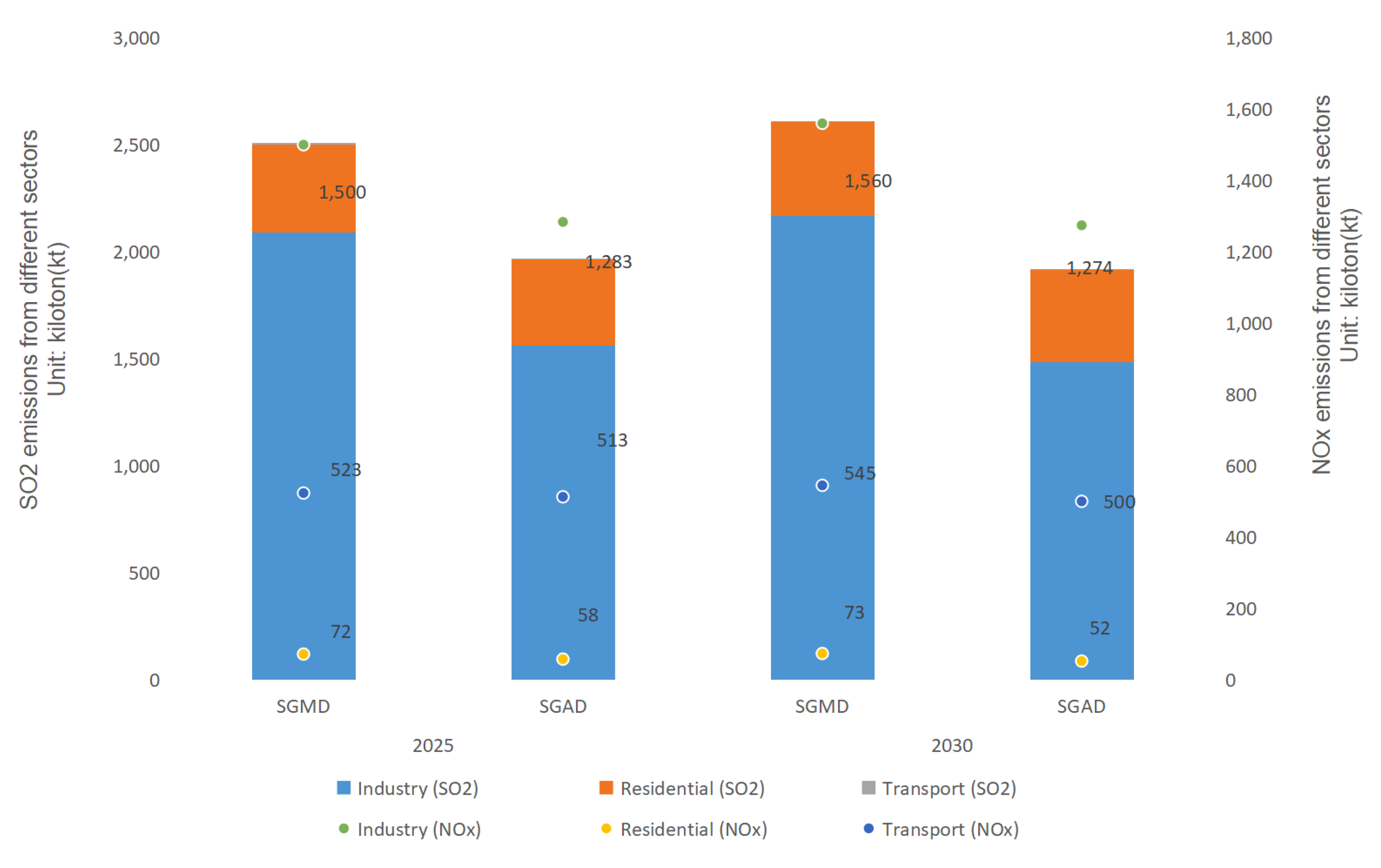
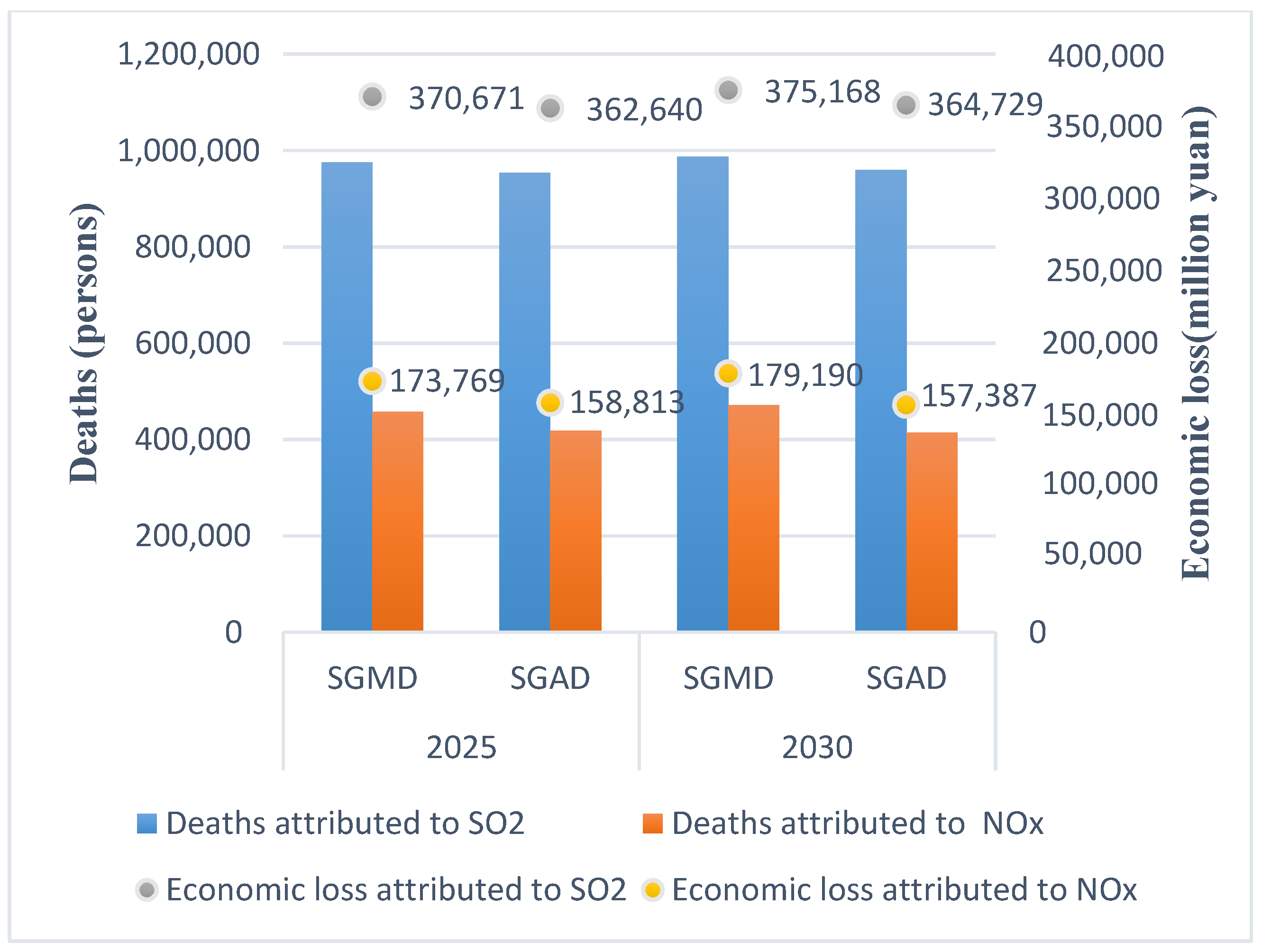
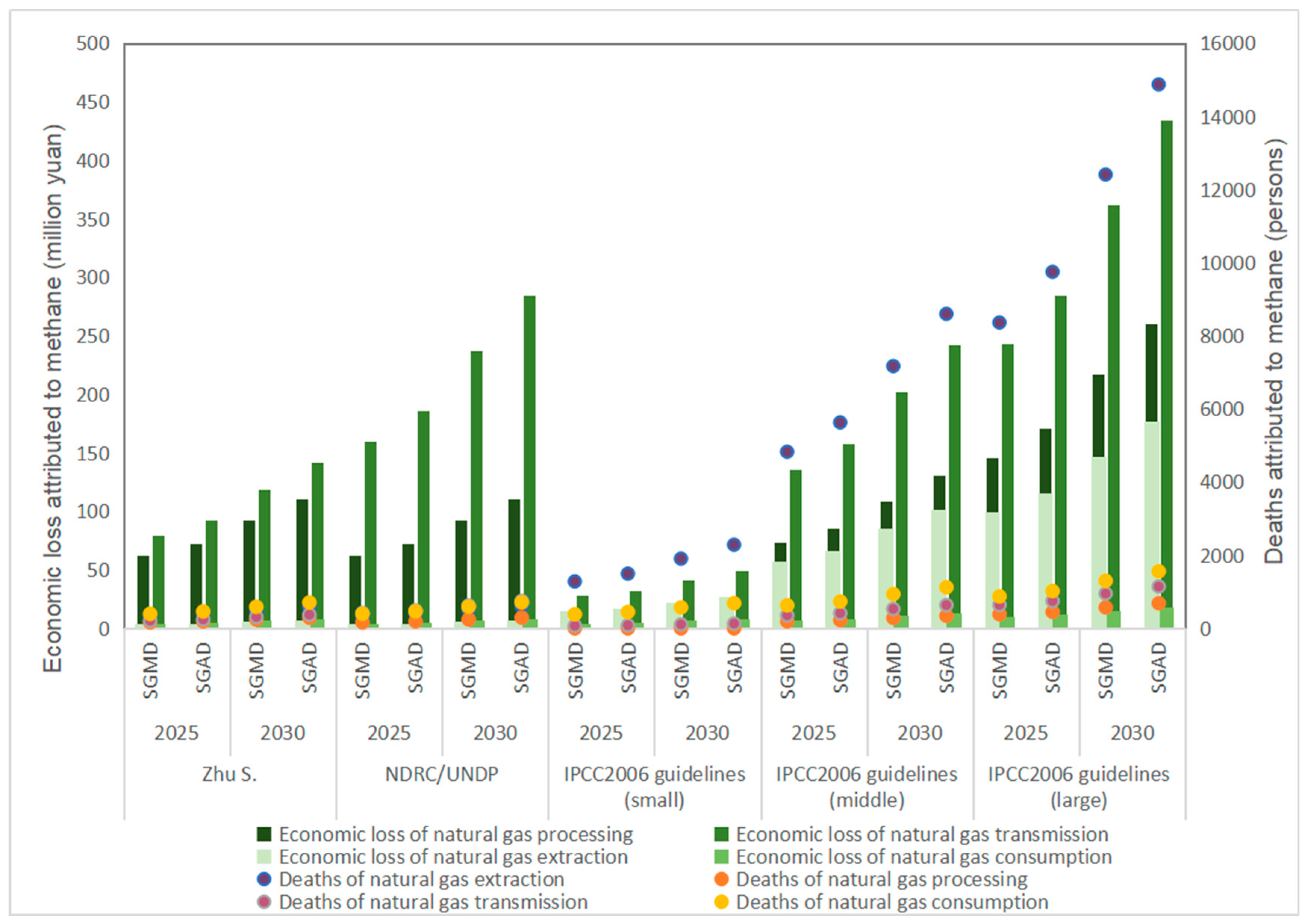
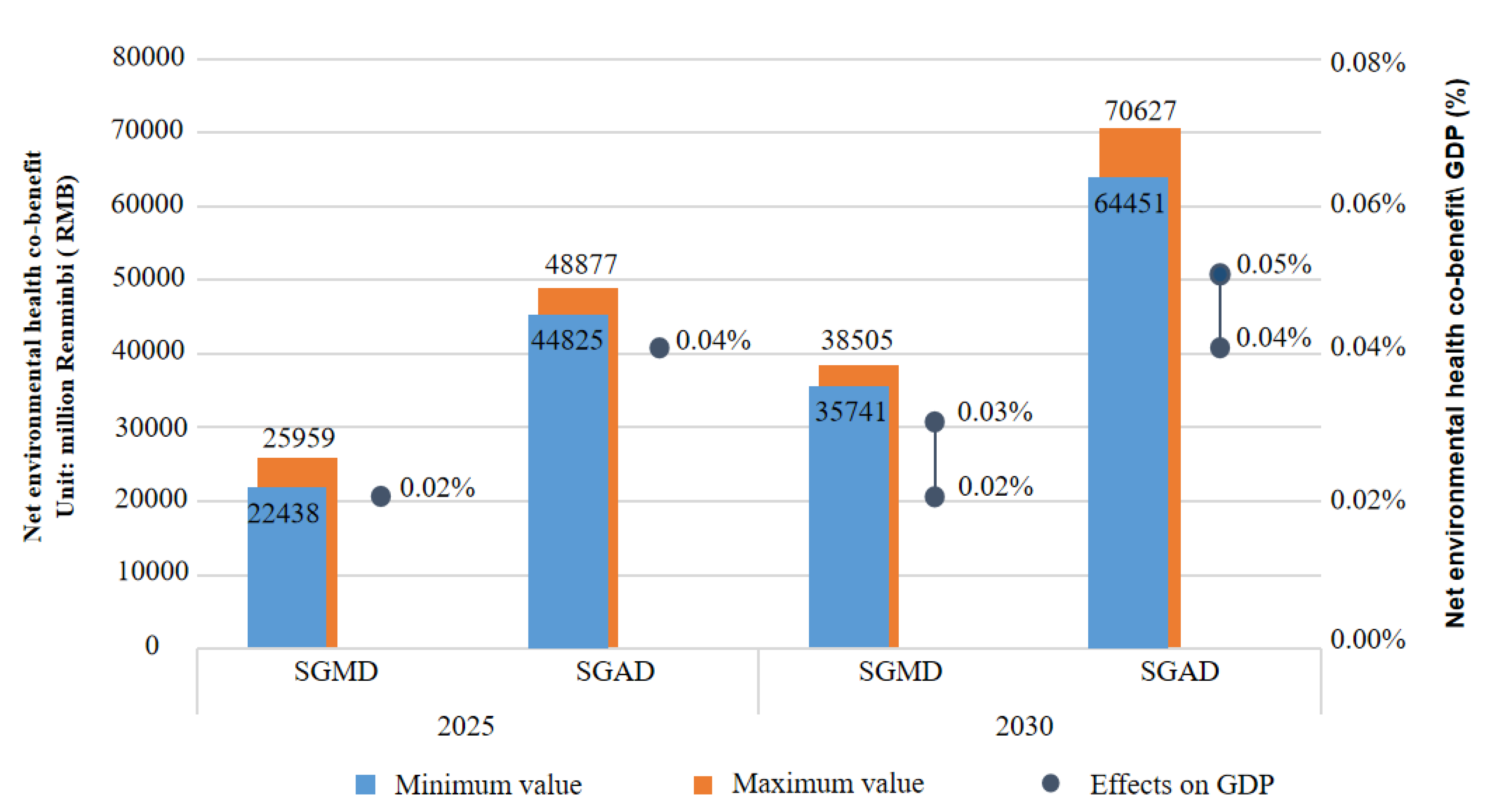
| Variable code | Description |
|---|---|
| OBJ(y0) | The total system cost discounted to y0 |
| Energy service demand d in region r, period t | |
| Capacity of new technology p in period v, region r | |
| Capacity of installed technology p in period t, region r | |
| Total capacity of installed technology p in period t, region r | |
| Activity level of technology p in period t, region r | |
| Amount of product c produced or consumed by technology p in period t, region r | |
| The amount of commodities c stored or released by technology p in period t, stage s, region r | |
| The amount of commodities c imported and exported by technology p in period t, region r by technology p |
| The SGMD Scenario | The SGAD Scenario | |||
|---|---|---|---|---|
| 2025 | 2030 | 2025 | 2030 | |
| Natural gas production | 249 | 274 | 260 | 300 |
| Shale gas production | 72.86 | 108.33 | 85 | 130 |
| Shale gas production ratio | 29% | 40% | 33% | 43% |
| Accounting Method | 2025 | 2030 | ||
|---|---|---|---|---|
| SGMD | SGAD | SGMD | SGAD | |
| Zhu S. [70] | 243.71 | 284.32 | 362.36 | 434.84 |
| NDRC/UNDP [71] | 292.97 | 341.79 | 435.6 | 522.74 |
| IPCC 2006 guidelines (small) [72] | 387.09 | 451.59 | 575.53 | 690.66 |
| IPCC 2006 guidelines (middle) [72] | 1338.22 | 1561.19 | 1989.69 | 2387.7 |
| IPCC 2006 guidelines (large) [72] | 2289.34 | 2670.79 | 3403.85 | 4084.74 |
| Link | The SGMD Scenario | The SGAD Scenario | Accounting Method | ||
|---|---|---|---|---|---|
| 2025 | 2030 | 2025 | 2030 | ||
| Natural gas extraction | 72.60 | 107.94 | 84.69 | 129.53 | Zhu S. [70] |
| Natural gas processing | 36.30 | 53.97 | 42.35 | 64.76 | |
| Natural gas transmission | 46.67 | 69.39 | 54.44 | 83.27 | |
| Natural gas consumption | 88.15 | 131.07 | 102.84 | 157.28 | |
| Total | 243.71 | 362.36 | 284.32 | 434.84 | |
| Natural gas extraction | 75.19 | 111.79 | 87.72 | 134.15 | NDRC/UNDP [71] |
| Natural gas processing | 36.30 | 53.97 | 42.35 | 64.76 | |
| Natural gas transmission | 93.34 | 138.78 | 108.89 | 166.54 | |
| Natural gas consumption | 88.15 | 131.07 | 102.84 | 157.28 | |
| Total | 292.97 | 435.6 | 341.79 | 522.74 | |
| Natural gas extraction | 285.20 | 424.04 | 332.72 | 508.86 | IPCC 2006 guidelines (small) [72] |
| Natural gas processing | 0 | 0 | 0 | 0 | |
| Natural gas transmission | 16.33 | 24.29 | 19.06 | 29.14 | |
| Natural gas consumption | 85.56 | 127.21 | 99.81 | 152.66 | |
| Total | 387.09 | 575.53 | 451.59 | 690.66 | |
| Natural gas extraction | 1075.96 | 1599.77 | 1255.24 | 1919.78 | IPCC 2006 guidelines (middle) [72] |
| Natural gas processing | 42.78 | 63.61 | 49.91 | 76.33 | |
| Natural gas transmission | 79.47 | 118.15 | 92.71 | 141.79 | |
| Natural gas consumption | 140.01 | 208.16 | 163.33 | 249.8 | |
| Total | 1338.22 | 1989.69 | 1561.19 | 2387.70 | |
| Natural gas extraction | 1866.73 | 2775.51 | 2177.77 | 3330.71 | IPCC 2006 guidelines (large) [72] |
| Natural gas processing | 85.56 | 127.21 | 99.81 | 152.66 | |
| Natural gas transmission | 142.6 | 212.02 | 166.36 | 254.43 | |
| Natural gas consumption | 194.45 | 289.12 | 226.85 | 346.95 | |
| Total | 2289.34 | 3403.85 | 2670.79 | 4084.74 | |
| Acronym, Common Name or Chemical Name | Chemical Formula | Lifetime (Years) | GWP (20-Year) | GWP (100-Year) |
|---|---|---|---|---|
| Carbon dioxide | CO2 | No single lifetime can be given. The impulse response function for CO2 from Joos et al. (2013) has been used. | 1 | 1 |
| Methane | CH4 | 12.4 (Perturbation lifetime is used in calculation of metrics, not the lifetime of the atmospheric burden) | 84 | 28 |
Publisher’s Note: MDPI stays neutral with regard to jurisdictional claims in published maps and institutional affiliations. |
© 2020 by the authors. Licensee MDPI, Basel, Switzerland. This article is an open access article distributed under the terms and conditions of the Creative Commons Attribution (CC BY) license (http://creativecommons.org/licenses/by/4.0/).
Share and Cite
Yang, X.; Gu, A.; Jiang, F.; Xie, W.; Wu, Q. Integrated Assessment Modeling of China’s Shale Gas Resource: Energy System Optimization, Environmental Cobenefits, and Methane Risk. Energies 2021, 14, 53. https://doi.org/10.3390/en14010053
Yang X, Gu A, Jiang F, Xie W, Wu Q. Integrated Assessment Modeling of China’s Shale Gas Resource: Energy System Optimization, Environmental Cobenefits, and Methane Risk. Energies. 2021; 14(1):53. https://doi.org/10.3390/en14010053
Chicago/Turabian StyleYang, Xi, Alun Gu, Fujie Jiang, Wenli Xie, and Qi Wu. 2021. "Integrated Assessment Modeling of China’s Shale Gas Resource: Energy System Optimization, Environmental Cobenefits, and Methane Risk" Energies 14, no. 1: 53. https://doi.org/10.3390/en14010053
APA StyleYang, X., Gu, A., Jiang, F., Xie, W., & Wu, Q. (2021). Integrated Assessment Modeling of China’s Shale Gas Resource: Energy System Optimization, Environmental Cobenefits, and Methane Risk. Energies, 14(1), 53. https://doi.org/10.3390/en14010053




